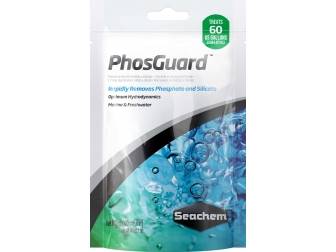


 0
0
- Eliminates silicate and phosphate
- Spherical for optimal hydrodynamics
- Irreversible binding


 In stock - Dispatched within 24 hours
In stock - Dispatched within 24 hours
- Eliminates silicate and phosphate
- Spherical for optimal hydrodynamics
- Irreversible binding
PhosGuard™ rapidly removes phosphate and silicate from marine and freshwater aquariums. Although PhosGuard™ is effective in both freshwater and seawater, it will perform better in seawater, and its need is more clearly defined in seawater. It is not recommended for phosphate-buffered freshwater (PhosGuard™ would remove the buffer until saturation). PhosGuard™ is highly porous and bead-shaped to promote easy water flow through and around it, thus increasing its efficiency and capacity.
Sizes: 100 ml, 250 ml, 500 ml, 1 L, 2 L, 4 L
| Product | Sure, I can help you with that. However, "PO" is not enough context to provide a translation. Could you please provide more text or specify what "PO" refers to?4Linked |
|---|---|
| PhosGuard (aluminum oxide) | 0.87 mg/g |
| PhosBondIt looks like you might have accidentally typed a parenthesis. Could you please provide the text you would like translated from French to English?hybrid"GFO and alumina oxide" | 1.19 mg/g |
| PhosNetSure, please provide the text you would like to have translated from French to English. | 1.41 mg/g |
Can generate heat upon initial contact with water. Pre-wet by adding to a double volume of fresh water, followed by rinsing. For best results, PhosGuard™ should be rinsed before use and placed in a manner that maximizes water flow through it but not in a way that it tumbles against itself during flow. It can be used in a cartridge filter, a media chamber, a canister filter, or any high-flow area of a trickle filter. Using a filter bag is recommended. Use 85 mL (1/3 cup) for every 200 L (50 US gallons) of saltwater or 400 L (100 US gallons) of freshwater.
Leave the product in place for 4 days, then test the phosphate or silicate concentrations with MultiTest™ Phosphate or MultiTest™ Silicate .
If the concentration of the component you are trying to reduce has not dropped to around 0.02 mg/L, replace the PhosGuard™; otherwise, leave it in place until the levels start to rise again.
As long as the concentrations remain under control, the product is not depleted.
Excessive treatment is not recommended. PhosGuard™ is not an exchange resin and does not release anything into the water.
It does not retain phosphate or silicate in the water and can be removed, dried, and put back into service until it is exhausted.
Continuous use of small amounts is preferable to intermittent use of large amounts.
PhosGuard™ is best used in small quantities and changed frequently. In an environment with an excessively high phosphate reading, PhosGuard™ depletes quickly (4 to 5 days). Place the product in a high-flow area and test your phosphate levels, changing as needed. When you see that your level is below 0.2 ppm (mg/L), leave that portion of PhosGuard™ in the filter. PhosGuard™ may yellow a bit as it picks up organic matter, but this is not an indicator of depletion for phosphate removal. Continue to test weekly for phosphate until you see it starting to increase again. You will then know it is time to change the PhosGuard™. If you have low phosphate levels, PhosGuard™ will absorb the silicate from your system. It is inert and safe to leave in your filter.
Although some manufacturers claim that their aluminum oxide-based phosphate removal products can be regenerated using intense heat, this is unfortunately not the case. This assertion is based on a naive interpretation of the information provided by bulk aluminum oxide manufacturers. Aluminum oxide is more commonly used in gas purification to remove volatile organic compounds and moisture; heating the material after such use will release the non-covalently adsorbed compounds. However, heat cannot cause the release of phosphate from aluminum oxide due to a difference in the nature of how phosphates are bound to aluminum oxide compared to adsorbed gases.
I was told that products containing aluminum oxide will release aluminum, which will close the corals for weeks and could even damage them. Is this correct?
In recent years, there have been speculations that aluminum oxide-based removers like PhosGuard™ release aluminum into the water and subsequently damage corals. The evidence supporting this claim was largely anecdotal.
Thus, through a series of controlled experiments in fresh water and salt water, we aimed to address both the question of aluminum solubility and aluminum toxicity. The results of these experiments show that under reef conditions (pH close to 8), no detectable soluble aluminum is released by alumina. Under conditions of low pH and high doses, soluble aluminum can be released from alumina; at three times the labeled dosage rate, we detected 0.2 mg/L of aluminum at a pH of 5.3.
Furthermore, aluminum oxide is not easily absorbed into the cell to cause negative reactions. Even at three times the dose of PhosGuard™, soft-bodied corals such as Sarcophyton remain unaffected.
Phosphate plays a major role in aquarium chemistry, and an overdose of PhosGuard™ can quickly lower the phosphate concentration in the aquarium. If an overdose of PhosGuard™ is used, it might reduce the phosphate concentration so rapidly that the corals become stressed.
Not at all! If a phosphate absorber takes several months to reach its full capacity when the tank is rich in phosphates, it means that the medium is exceptionally slow at absorbing phosphate. PhosGuard™ needs to be replaced every 4 days as long as there is a phosphate problem because, given an infinite amount of phosphate available, PhosGuard™ absorbs phosphate so quickly that it reaches its full capacity in 4 days. The 4-day replacement period is based on how quickly the medium works, not on the maximum capacity of the medium.
We do not recommend it because the tumbling action of a media reactor can cause the production of dust from this media.